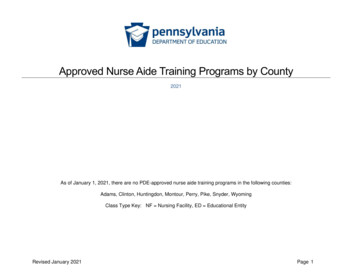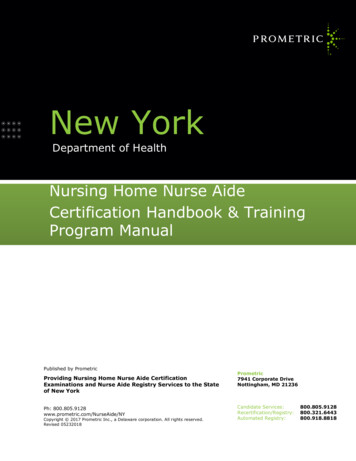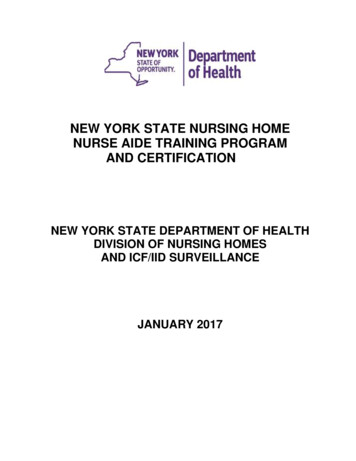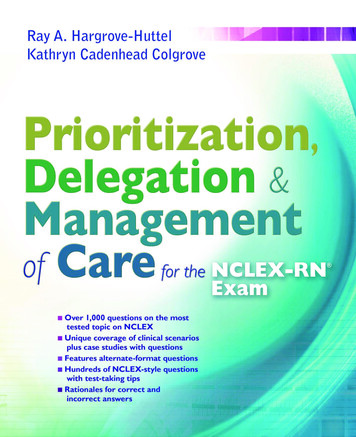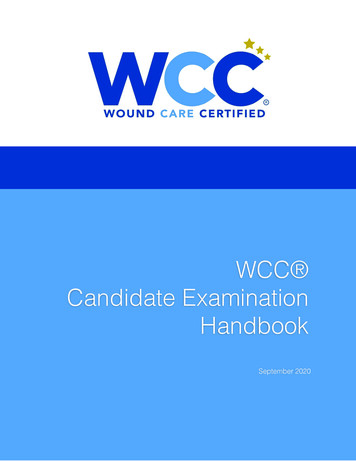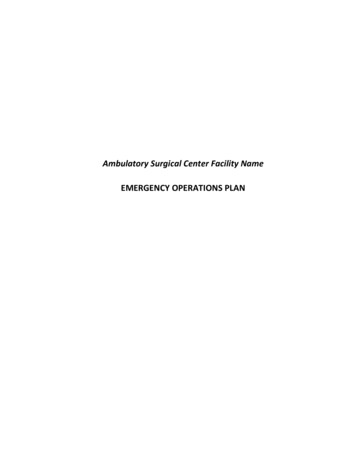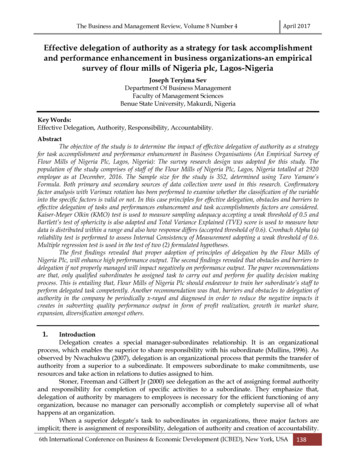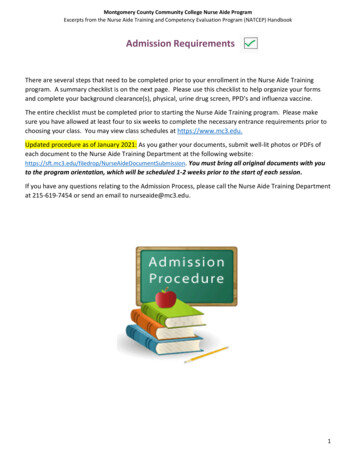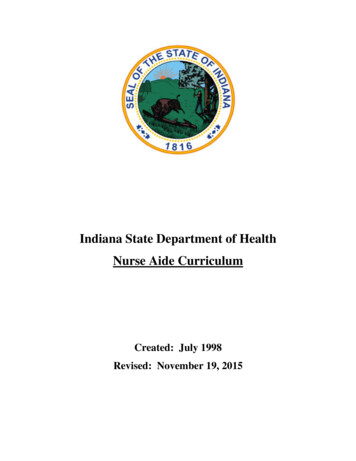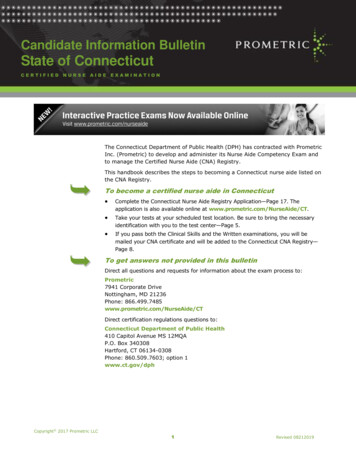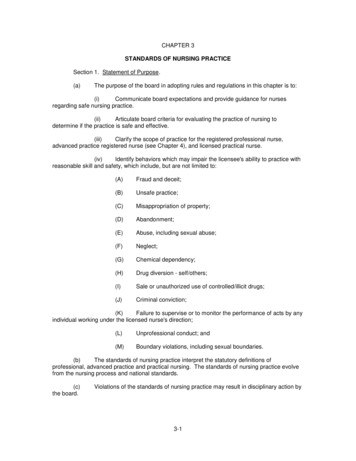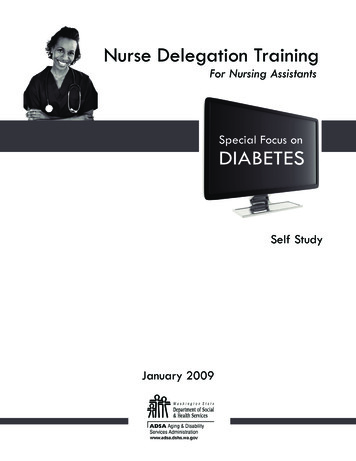
Transcription
Nurse Delegation TrainingFor Nursing AssistantsSpecial Focus onDIABETESSelf StudyJanuary 2009
AcknowledgementsStakeholder Workgroup:Linda Amondson-Muller, RN—Registered Nurse DelegatorVicki Anensen-McNealley, PhD, MN, RN—Washington Health Care AssociationLinda Batch, LPN—Nursing Care Quality Assurance Commission, Department ofHealthBonnie Blachly, MN, RN—Director of Clinical and Regulatory Issues, AgingServices of WashingtonNancy James—Director of Professional Affairs, Home Care Association ofWashingtonDiana Klages, RN—Registered Nurse Delegator; Director of Nursing, SL StartRuss Larder, RN—Registered Nurse Delegator, Providence ElderPlace andBeacon DelegationTory Lucas, RN, CDE—Deaconess Medical Center, Diabetes Education;contracted teacher for Aging and Long Term Care of Easter WashingtonNancy Mohrman, M.Ed.—Foss Home and VillageJanet Rhode, ARNP, MN—Washington State Residential Care Council StateEducation Chair; Owner, Evergreen Adult Family HomesAdditional Contributions:Special thanks to Stakeholder Workgroup member Tory Lucas, RN, CDE, foradditional curriculum consultation and permission to use and adapt “The 5 M’s ofDiabetes Management” as a learning tool.Special thanks to Dr. Terry W. Miller and the School of Nursing at PacificLutheran University for use of the Learning Resource Center.
Table of ContentsIntroduction . 1Module 1—All About Diabetes . 4Diabetes .4High Blood Sugar .7Recognizing High Blood Sugar .8High Blood Sugar Review .9High Blood Sugar and Serious Health Problems . 10Managing Diabetes . 11Diabetes Management Plans (The Four M’s). 12You and Your Client’s Health . 15Module 1 Review . 16Module 1 Practice Test . 18Module 1 Answer Key . 20Module 2—All About Insulin . 22Prescribed Insulin . 22Appearance . 22Containers . 23Prescription Labels . 24Expiration Dates . 24Storage . 25Summary Table: Information to Know about Prescribed Insulin . 26Low Blood Sugar and Prescribed Insulin . 28Low Blood Sugar and the Four M’s . 29Low Blood Sugar and the Four M’s Review . 32Other Factors that Affect Blood Sugar . 33Summary Table: Factors That Affect Blood Sugar . 34Low Blood Sugar . 35Recognizing Low Blood Sugar . 36What to Do When Low Blood Sugar Occurs . 37Low Blood Sugar Review . 40Insulin Categories . 41Module 2 Review . 42Module 2 Practice Test . 44Module 2 Answer Key . 46
Module 3—All About Insulin Injections .48Skin . 48Injection Sites . 49Syringes . 51Special Considerations . 55Vials . 57The Medication Administration Process . 59Administering a Single Type of Insulin . 60Step 1: Evaluate the Client . 60Step 2: Set Up the Medications . 61Step 3: Administer the Medication . 65Step 4: Document the Administration . 68Step 5: Observe the Client for Side Effects . 68Checklist for Administering a Single Type of Insulin in a Syringe . 69Module 3 Practice Test . 71Module 3 Answer Key . 73Appendix A—Module 1 ResourcesVisualization Exercise (How High Blood Sugar Can Damage the Body). 76Healthy Food Choices (Nutritional Table). 78Plate Method . 79Diabetes and Your Client’s Physical Activity Plan . 8010 Ways to Help Motivate Your Client . 81Job Aid: High Blood Sugar (Symptoms and What to Do for It). 82Appendix B —Module 2 ResourcesJob Aid: Summary Table (Information to Know about Prescribed Insulin) . 84Job Aid: Summary Table (Factors that Affect Blood Sugar) . 86Job Aid: Low Blood Sugar (Symptoms and What to Do for It) . 88Insulin Table (Categories and Action Times) . 90Appendix C —Module 3 ResourcesJob Aid: Injection Sites (and Guidelines for Injection Sites). 92Job Aid: Skill Checklist (Administering a Single Type of Insulin in a Syringe) . 94Sliding Scales (Description and Examples). 96Insulin Pens (General Information) . 98Mixing Two Types of Insulin in One Syringe (Information and Steps).102Additional Resources—Websites .106
IntroductionIntroduction
IntroductionIntroductionWelcome to Nurse Delegation for Nursing Assistants:Special Focus on Diabetes.In spring of 2008, a law was passed by the WashingtonState legislature allowing nursing assistants to performinsulin injections as a nurse delegated task.Because of this law and nursing assistants like you, DSHSclients with diabetes now have the choice and freedomto live at home or in a residential care facility wheninsulin injections are needed.Because of you, your DSHS clienthas more freedom and choices.Who Must TakeThis Course?This self-study course is designed for nursing assistants who: Are registered or certified (NA-R’s or NA-C’s). Have successfully completed the Nurse Delegation for NursingAssistants Self-Study Training Course. Need this additional, required training to administerinsulin injections under nurse delegation.NurseDelegationSpecial Focus onDiabetesThe course includes this workbook anda companion DVD. Both the workbook and DVD are divided into threesections or Modules. Module 1: All About Diabetes Module 2: All About Insulin Module 3: All About InsulinInjectionsCourse ProcessNurse Delegation Training: Special Focus on DiabetesPage 1
Course ProcessContinuedThis workbook is yours to keep and use. It contains information, jobaids, and checklists that you can use as a valuable resource in thefuture.The DVD repeats key information from the modules and demonstratesand reinforces important concepts from the workbook.Use this workbook and DVD for each Module: Read Module 1. Watch the first DVD segment. Take the Practice Test for Module 1. Review the Answer Key for the Practice Test. Re-read and/or review sections where you missed questions. Repeat these steps for Modules 2 and 3.LearningAidsTo help you identify and learn important concepts, the workbook: Boxes KEY WORDS you need to know. Provides Summary Tables and Review boxes. Contains helpful information/job aids in the back (Appendices). Uses the following icons:A critical safety concept that you must know andapply as you care for your client.A description of how your delegating RN will workwith you on a particular aspect of your client’s care.An important rule that you must know and followwhen handling and administering insulin.A reminder to verify the 5 Rights of MedicationAdministration.A section or module review that reinforces keyconcepts from the text.A reminder to stop and move on to a different partof the training.Nurse Delegation Training: Special Focus on DiabetesPage 2
SuccessfullyCompleting theCourseThe Practice Tests at the end of each Module are designed toprepare you for the final written test. The final written test is verysimilar in format and content.To successfully complete this course, you will need to: Present your workbook—with practice tests completed—to yourinstructor for review. Pass the final written test. Return the DVD to the Training Coordinator.Once you pass the written test, you can begin your hands-ontraining with your delegating RN. This on-the-job training is anessential part of learning to work with insulin and administer itsafely.Hands-onTrainingFor your own confidence and the safety of your client, you willreceive this ongoing training, practice, and supervision before andafter you begin administering insulin.Your on-the-job training includes: Hands-on practice. Learning the specifics about your client’s care needsrelated to the delegated tasks you will be performing.Your delegating RN will work with you to make sureyou are competent to administer your client’s insulinsafely before you give an insulin injection to yourclient.As with any delegated task, tell the delegating RN ifyou have concerns or questions about being able toperform the task safely.After you have begun administering insulin to yourclient, your delegating RN will continue to superviseyou at least weekly for four weeks.You will have plenty of training, support,and supervision as you take on this task.As you can see, you will have plenty of training,supervision, and support as you take on this task.Good luck!Nurse Delegation Training: Special Focus on DiabetesPage 3
Page85
All AboutDIABETESModule
All AboutDIABETESModuleIn Module 1, you will learn about: What diabetes is and how it impacts a person’s health. High blood sugar. Your role in helping your client manage diabetes safely.DIABETESBasically, diabetes mellitus or simply DIABETES is an illness thatcauses the sugar level in a person’s blood to be too high. Anotherword for blood sugar is glucose.gGlucoseGLUCOSE is the type of sugar that is the mainsource of energy needed by the human body. In orderto live, the human body must have glucose.Not only does the body need to have glucose, the bodymust also control where glucose goes. Some of thebody’s glucose must stay in the blood, and some ofthe body’s glucose must leave the blood and moveto other parts of the body where it is needed or storedfor later use.When a person has diabetes, too much of the body’sglucose stays in the blood.ggNormal amount of glucose in bloodggggggggToo much glucose in bloodNurse Delegation Training: Special Focus on DiabetesPage 4
How the BodyNormallyUses GlucoseLet’s learn how the body uses glucose normally. After that, it will beeasy to understand what happens differently with diabetes.Where does glucose come from?If you think about glucose as energy for the body, you can probablyguess where it comes from. Yes, glucose comes mostly from food—or what a person eats and drinks.Amazingly, the body turns most of the food it gets into glucose.Foods high in sugar or carbohydrates—such as candy, desserts, orsugary drinks—create especially high amounts of glucose.Where does the glucose go?After a person eats, glucose goes into the blood. Glucose travelsaround or circulates inside of the blood vessels, mixing with theblood.Normally, how does extra glucose move out of the bloodand get to the rest of the body?To move out of the blood, glucose must get through tiny “doors” orcells in the walls of the blood vessels. But first, glucose must havethe “key” to unlock those doors.The key that unlocks the doors and allows extra glucose to leave theblood is a hormone called INSULIN .IInsulinNormally, how does insulin work?After a person eats, the body senses that the amount of glucose inthe blood is getting higher. The body then sends insulin into theblood. Once in the blood, insulin acts like a key and allows extraglucose to leave the blood. INurse Delegation Training: Special Focus on DiabetesPage 5Insulin is the key thatunlocks the doors andallows extra glucose toleave the blood.
How the BodyWorks DifferentlyWith DiabetesNow let’s look at what happens differently with diabetes. Simplystated, when a person has diabetes, the body’s insulin does not worknormally. This can happen for different reasons:Insulin might not work normallybecause. . .This problem is called .The body may not make any insulinType 1 diabetesThe body may make too little insulinType 2 diabetesThe tiny “doors” or cells of the bloodvessels may not unlock for insulin theway that they shouldInsulin Resistance(part of Type 2 diabetes)For your work purposes, the reasons why insulin may not worknormally are not as important as this one concept:When a person has diabetes, thebody’s insulin is not able to act likea key to help extra glucose leavethe blood. As a result, too muchglucose stays in the blood. IIggggggWhat Happens After a Person Eats?Normally . . . Food is turned into glucose that entersthe blood. The body senses the amount of glucosein the blood is getting higher. With diabetes . . . Food is turned into glucose that entersthe blood. The body senses the amount of glucosein the blood is getting higher.The body sends insulin into the blood. Insulin is not able to work normally.Insulin acts like a key to help extraglucose move out of the blood. Extra glucose builds up in the blood.Nurse Delegation Training: Special Focus on DiabetesPage 6
HIGH BLOOD SUGARToo much glucose in the blood is called HIGH BLOOD SUGARor HYPERGLYCEMIA . You may also hear people call it highblood glucose.Blood sugar levels can be measured using a machine called aGLUCOMETER .Your delegating RN will: Show you how to use your client’s glucometer. Let you know when your client’s blood sugar needs tobe checked.Except for the first two hours after a person eats--when it is normalfor blood sugar to get higher--the NORMAL RANGE for bloodsugar levels is between 70-140 mg/dl .Blood sugar higher than 140 mg/dl two or more hours aftereating is considered high.Target RangeSome people with diabetes struggle each day to keep their bloodsugar from being too high. It is very difficult for them to keep theirblood sugar within the normal blood sugar range.As a result, healthcare providers give some people with diabetes anindividualized TARGET RANGE for their blood sugar.For example, a client’s Target Range might be 70-200 mg/dl. Thismeans that the client has a goal of keeping high blood sugar fromgoing above 200 mg/dl.Your delegating RN will let you know: If your client has an individualized Target Range andwhat it is. The plan and steps you need to take if your client hashigh blood sugar above this individualized Target Range.Sample Target RangeAlways follow the plan and steps that come from your delegating RN.Nurse Delegation Training: Special Focus on DiabetesPage 7
Common HIGH BLOOD SUGAR SYMPTOMS include fatigueor drowsiness, blurred vision, frequent urination, extreme thirst,weakness, headache, and dry skin and mouth.Nausea, rapid breathing, or sweet/fruitybreath odor are considered “late” symptomsof high blood sugar because they usually occurafter other symptoms.Late symptoms usually mean that aperson’s blood sugar is dangerouslyhigh and requires immediatemedical attention.Recognizing HighBlood SugarHigh Blood SugarSymptomsHeadacheFatigueWeaknessDrowsinessIf a person with diabetes shows symptoms ofhigh blood sugar, then check his or her bloodsugar level using a glucometer.High blood sugar can lead to a medicalemergency if not treated. As a result,healthcare providers usually prescribeindividualized plans for diabetic patientswho experience high blood sugar above theirTarget Range.Dry skinand mouthBlurredvisionFrequenturinationYour delegating RN will let you know: The plan for your client and the steps youneed to take if your client has high bloodsugar above the Target Range.ExtremeThirstLate SymptomsNauseaRapid breathingSweet/fruity breath odorAlways follow the plan and steps that come from your delegating RN.Call 911 immediately if your client is non-responsive.Notify your delegating RN as soon as possible after theclient has received emergency help.Nurse Delegation Training: Special Focus on DiabetesPage 8
HIGH BLOOD SUGAR REVIEW:Important Points to RememberKnow your client’s individualized Target Rangefor blood sugars.Use a glucometer to check your client’s blood sugar ifhe or she shows symptoms of high blood sugar.Follow your delegating RN’s instructions for highblood sugar whenever your client’s blood sugar testsabove his or her individualized Target Range.Call 911 immediately if your client is nonresponsive. Notify your delegating RN as soon aspossible after your client has received emergency help.Nurse Delegation Training: Special Focus on DiabetesPage 9
HIGH BLOOD SUGAR ANDSERIOUS HEALTHPROBLEMSOver time, high blood sugar can lead to serious health problemsby causing damage to large blood vessels, small blood vessels,nerves, and the body’s ability to fight infection.Damage to. . .Large BloodVesselsCan lead to these health problems. . . Small BloodVessels Nerves The Body’sAbility to FightInfectionHigh blood pressureStrokeHeart attackEye problems that can lead to poorvision or blindnessKidney disease or kidney failurePoor circulation and healing, especiallyin the legs and feetPainLoss of feeling and muscle weaknessespecially in the feet, legs, and hands Wounds and amputations related to loss offeeling and poor circulation and healing Frequent infectionsDental problems To better visualize how high blood sugar can damage the body, seepage 76 in Appendix A.Nurse Delegation Training: Special Focus on DiabetesPage 10
MANAGING DIABETESThe good news is: diabetes can be managed! Did you know thatserious health problems from diabetes can be prevented?The best way for people to manage diabetes is to keep their bloodsugar levels within their Target Ranges.People with diabetes cantake action steps toprevent serious healthproblems.Fortunately, there are ways to control blood sugar when a person isdiabetic and the body’s insulin does not work normally. Yes, peoplewith diabetes can take action steps to prevent serious healthproblems.Action steps to stay healthy are different for each person withdiabetes. These action steps are part of each person’s individualizedDIABETES MANAGEMENT PLAN .A person’s Diabetes Management Plan is developed with help fromhealthcare providers or the person’s DIABETES CARE TEAM .For some, the diabetes care team may include a doctor, a registereddietician, and a pharmacist. For others, the diabetes care team mayalso include a nurse educator, a podiatrist (foot doctor), and adelegating RN.You are an importantpart of the care team.Because you will be providing care under nurse delegation, yourclient will always have a delegating RN on the diabetes care team-and you will also be an important member of the team.Your delegating RN will: Teach you about your client’s Diabetes ManagementPlan. Let you know when and what to communicate andreport to him or her.Always follow the plan and steps that come from your delegating RN.Nurse Delegation Training: Special Focus on DiabetesPage 11
DIABETESMANAGEMENTPLANSMost Diabetes Management Plans contain action steps in four areas.An easy way to remember the four parts of a Diabetes ManagementPlan is to think of them as THE FOUR M’s: MEALS,MOVEMENT, MEDICATION, AND MONITORING.Let’s look briefly at each of these areas and learn how they can helppeople with diabetes stay as healthy as g medicationsas prescribedMonitoring bloodsugar levels2MEALSMOVEMENTEatinghealthyGetting physicalactivityMaking healthy food choices can help people with diabetes tocontrol their blood sugar levels.Eating Healthy1Some people with diabetes need to follow daily meal plans. Theseplans are individualized for each person. Other people do not usedaily meal plans, but try to make healthy food choices each day.MEALSFood choices that are healthy for people with diabetes are the samefood choices that are healthy for people in general. Find helpfulinformation about healthy food choices on page 78 and a mealplanning tool on page 79 in Appendix A.EatinghealthyIf your client has a specialized diet or needs to follow a daily mealplan, the details will be included in the client’s individualized careplan or the instructions from your delegating RN.Do not make changes in your client’s dietary habits without notifying your client’s case manager or your delegatingRN. Dietary changes need to be written in your client’sindividualized care plan or the instructions from yourdelegating RN.Nurse Delegation Training: Special Focus on DiabetesPage 12
Getting PhysicalActivity2MOVEMENTGetting physicalactivityGetting regular physical activity canhelp people with diabetes to controlhigh blood sugar.Generally, everyone should try to getsome physical activity every day.However, many people have limits onhow much or what kind ofexercise they can do.Because exercise lowers blood sugar, people with diabetes need tobe careful about changing their physical activity patterns suddenly.Doing too much too fast can make blood sugar too low,which would be dangerous. To be safe, people withdiabetes need to set individualized exercise goals with thehelp of their healthcare providers.If your client has a specialized exercise plan, the details will beincluded in the client’s individualized care plan or the instructionsfrom your delegating RN.Do not make changes in your client’s exercise habitswithout notifying your client’s case manager and/or yourdelegating RN. New exercise plans need to be written inyour client’s individualized care plan or the instructionsfrom your delegating RN.Find some additional helpful information on exercise and diabeteson page 80 in Appendix A.Taking Medications3MEDICATIONTaking medications asprescribedSome people with diabetes do not need medications to help themcontrol their blood sugar levels, but many do.One person may use one or more types of oral medications or pills.Another person may need injections of one or even two types ofinsulin. Another person may use a combination of oral medicationand insulin injections.Healthcare providers work with people individually to create thebest list of prescribed medication for them.Nurse Delegation Training: Special Focus on DiabetesPage 13
You may be helping your client with diabetes medications undernurse delegation, including insulin injections.You will learn more about insulin and injections in the next twotraining modules. For now, what you need to know is this:Your delegating RN will: Teach you about your client’s individualizedmedication list. Give you specific instructions about helping yourclient with diabetes medications.Always follow the plan and steps that come from your delegating RN.Never administer a client’s medications before youhave received instruction and approval from yourdelegating RN.Regular monitoring of blood sugar levels with a glucometer can helppeople to manage their diabetes better.Monitoring blood sugar levels tells people how close they are totheir Target Range. If they are frequently outside of their TargetRange, then they can work with their healthcare providers to makeneeded changes to their Diabetes Management Plan.Monitoring BloodSugar Levels4MONITORINGPeople with diabetes usually monitor their blood sugar according toan individualized schedule they set up with their healthcare provider.Monitoring bloodsugar levelsYour delegating RN will: Show you how to use your client’s glucometer. Let you know the plan for your client and the stepsyou need to take if your client has high blood sugar.Always follow the plan and steps that come from your delegating RN.Nurse Delegation Training: Special Focus on DiabetesPage 14
YOU AND YOURCLIENT’S HEALTH!You can make a positive difference in your client’s health!As you follow instructions and help your client with your assignedand delegated tasks of the Diabetes Management Plan—such asgiving medications as prescribed—you are helping your client tomanage diabetes.5MOTIVATIONAs you positively encourage and support your client’s efforts tofollow the Diabetes Management Plan, you are also helping yourclient to manage diabetes. Your positive support will help yourclient feel motivated about working so hard to stay healthy!In fact, feeling motivated is so important to your client, it can beconsidered THE FIFTH M: MOTIVATION to stay healthy!Motivation to stayhealthy!Finally, as you help your client with other assigned or delegated tasks—such as monitoring blood pressure or providing good skin care—you are helping to prevent or minimize serious health problems thatcan occur with diabetes.Learn ten ways you can help motivate your client to follow his orher Diabetes Management Plan on page 81 in Appendix A.So, remember, you are an importantmember of the Diabetes Care Team,and your work matters! Doing yourassigned and delegated tasks well isimportant.Nurse Delegation Training: Special Focus on DiabetesPage 15
MODULE REVIEW:Important Points to RememberDiabetes is an illness that causes high blood sugar.People with diabetes have high blood sugar because their body’s insulindoes not work normally to remove extra glucose from the blood.Too much glucose in the blood is called high blood sugar orhyperglycemia.Common symptoms of hyperglycemia include fatigue or drowsiness,blurred vision, frequent urination, and extreme thirst.If your client shows symptoms of high blood sugar: Do a blood sugar check using a glucometer. Follow your delegating RN’s instructions for high blood sugar. Call 911 immediately if the client is non-responsive. Notifyyour delegating RN as soon as possible after the client hasreceived emergency help.Over time, high blood sugar causes damage to: Large blood vessels. Small blood vessels. Nerves. The body’s ability to fight infection.Damage from high blood sugar can lead to serious health problemssuch as a heart attack, eye problems (low vision or blindness), poorcirculation and healing, loss of feeling, and frequent infections.Nurse Delegation Training: Special Focus on DiabetesPage 16
MODULE REVIEW:Important Points to Remember (continued)The normal range for blood sugar is 70-140 mg/dl.People who have difficulty keeping their blood sugar in the normal rangemay have an individualized Target Range as their goal.Each person with diabetes has a Diabetes Care Team, including the person’sdoctor and healthcare professionals such as your delegating RN and yourself.Your delegating RN is your link to the Diabetes Care Team. You will getinstructions from, communicate with, and report to your delegating RNregarding your client’s diabetes and care.The Diabetes Care Team works with the person with diabetes to develop aDiabetes Management Plan which usually includes the Four M’s: MEALS: Eating healthy MOVEMENT: Getting physical activity MEDICATIONS: Taking medications as prescribed MONITORING: Monitoring blood sugar levelsYou are an important member of the Diabetes Care Team. By performingyour delegated and assigned tasks well, you can make a positive difference inhelping your client to manage diabetes and feel the Fifth M: MOTIVATIONto stay healthy!IT’S TIMETO:WatchSegment 1 of theVideo:What is Diabetes?Nurse Delegation Training: Special Focus on DiabetesPage 17
PracticeTestModule 1Section 1—Multiple Choice:Place an “X” in the space next to the best answer for eachquestion below.1. When people have diabetes:a. It causes them to have frequent low blood sugar.b. Glucose (sugar) passes too easily from the blood.c. Their bodies do not produce glucose (sugar).d. The body’s insulin does not work nor
Dec 08, 2010 · Nurse Delegation Training: Special Focus on Diabetes Page 4 Module DIABETES Glucose g g g All About DIABETES Basically, diabetes mellitus or simply DIABETES is an illness that causes the sugar level in a person’s blood to be too high. Another word for blood sugar
